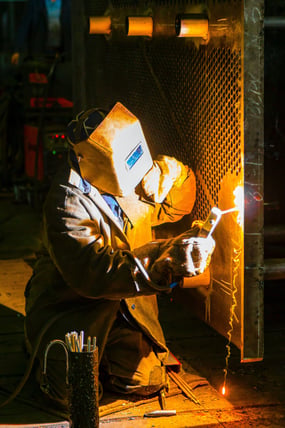Construction equipment plays an integral role in job completion without delays. In this installment of a four-part series, safety of laborers is the topic. Understanding what head gear to wear, proper eye and ear protection and welding safety are paramount in ensuring the safety of your workers. Safety of tradespeople ensures that projects are completed on time and without incident, resulting in lower costs. There are other types of protective clothing that should be worn but for the purposes of this article we will focus on the aforementioned. For additional information and suggestions about best practices, note that your insurance company may be a good resource.
Head Gear
Most tradespeople or contractors on a construction job site will already know that they need a hard hat. Head protection is something many people are taught at a young age, likely around when we first learn how to ride a bicycle. We learn that protecting our skull protects our brain, which is pretty important if you want to keep living and breathing. But hard hats don’t just protect your head from falling objects and flying debris, they also have insulation to protect you from electrical shock.
Conditions on a job site are constantly changing, so a good rule of thumb is to require everyone to wear a hard hat at all times. Some hard hats can be worn backwards if needed, as long as the suspension can be reversed. Be sure to check the manufacturer’s guidelines and directions for adjusting the suspension to ensure a secure and comfortable fit.
Another consideration is lighting. Head lamps are designed to go over hard hats to provide additional light to workers for certain tasks. Be sure to read the manufacturer's instructions on which head lamps will work with your hard hats.
Ear and Eye Wear
Hearing protection is extremely important, especially on certain job sites where noise is a problem. Hearing protection must be provided and used according to OSHA specifications. Acceptable forms of protection include ear muffs and ear plugs. Ear plugs must be individually fitted by a trained person, and cotton is NOT included as an acceptable form of ear plugs according to OSHA.
Eye protection is paramount for a variety of reasons, the largest of which is that the eyes are extremely soft and sensitive. Safety goggles, safety glasses, masks and other eye protection is necessary when workers are exposed to flying particles, molten metal, liquid chemicals, light radiation, vapors, acids, chemical gases and caustic liquids. If a worker needs corrective lenses, protection should incorporate the prescription or be designed to fit around glasses.
All facial protective gear should be flush against the skin with a snug fit. It should be comfortable, not painful, and should not interfere with a person’s movement or impede vision. It should also be capable of being disinfected for re-use, and each piece of equipment should be selected based on the presented hazard.
Welding
Welding is a common practice on some job sites, so ensuring that your welders have the proper equipment protects your tradesperson from injury and ensures that their work can be completed properly and safely. They should be provided with the proper filter lens shade number based on the welding being done. If working with lasers, safety goggles should be used which have been calibrated with the appropriate optical density based on the wavelength of the laser.
On top of ensuring that proper equipment is provided to your workers based on their respective job duties, training on this equipment should also be provided. Even workers who have been in the industry for some time may occasionally need updated training as new models of items are released and new safety measures are put into place. Head protection is of the upmost importance for any job.
Your company is ultimately responsible for the well-being of your employees and any contractors hired to complete a job. It is in your best interest to provide the necessary safety equipment, and it is in your best interest to provide training on the proper use of the equipment you are providing. Not only does this protect your business in the event of an accident, but it reduces the likelihood of an accident. Safety is something you can control, so be sure to follow OSHA guidelines and implement the appropriate measures.

Recent Posts
- Spec Home Loans: Complete Guide to Construction Financing for Builders
- Spec Construction Loans: A Spec Line of Credit Is Worth the Paperwork
- Spec Homes and Pre-Sale Homes: Relative Benefits for a Spec Builder
- Spec Construction Success: Insights for the Investor Builder
- How Is a Spec House Different From Other Kinds of House Construction?
